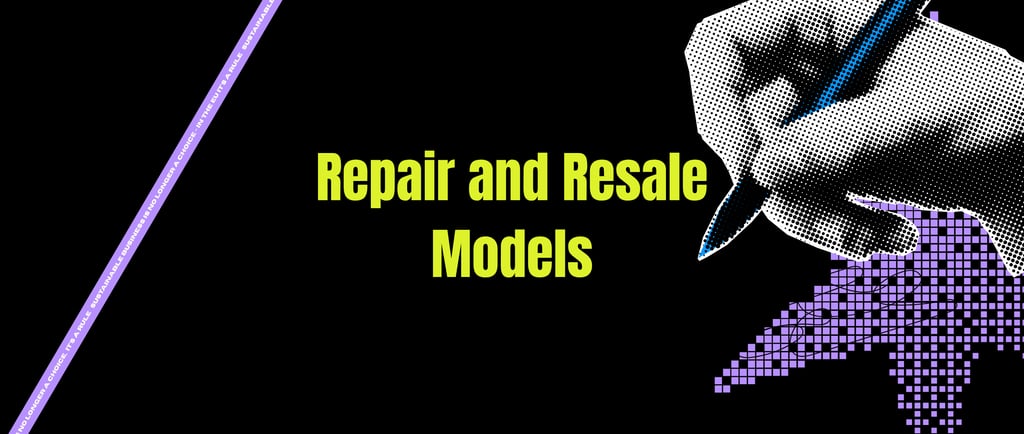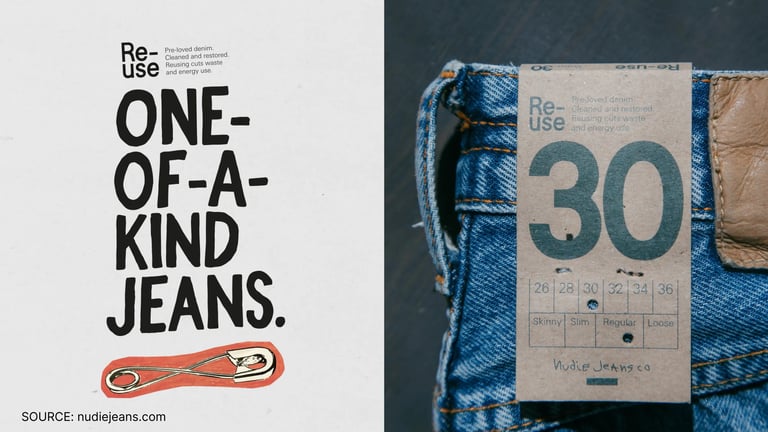Profitable Repair & Resale Models for Fashion Brands
Discover how EU fashion brands turn repair and resale into profit, new revenue, loyal customers, and lower compliance costs under upcoming EU rules.
10/29/20255 min read


Repair, Resale, and Revenue: The Business Case for Keeping Clothes in Use
Repair and resale used to be side projects, nice ideas for conscious consumers or small local shops.
Now, they’re shaping the future profit model for European fashion.
Under new EU rules, clothing brands will soon be expected to make their products last longer, help customers repair them, and take responsibility for what happens after sale. The Right to Repair Directive and Extended Producer Responsibility (EPR) for textiles mean that what used to be optional is now part of the business structure.
But compliance isn’t the whole story. Repair and resale are also proving to be commercially smart, reducing waste costs, increasing customer retention, and creating entirely new income streams.
Why the EU Is Pushing Repair and Resale
The Right to Repair Directive, adopted in mid-2024, requires brands to make repair services available and spare parts accessible for a reasonable period and price.
Meanwhile, the Ecodesign for Sustainable Products Regulation (ESPR) will soon introduce repairability and durability requirements for textiles.
These aren’t just sustainability measures, they’re economic ones.
Every repaired or resold product means fewer new items that end up in waste streams covered by EPR fees. It’s cheaper to support reuse than to pay for disposal.
That shift is why even mid-sized brands are turning repair and resale into profit centers instead of marketing gestures.
Rethinking Business Models
For small and medium brands, building repair or resale operations doesn’t need to mirror what big retailers do. It can be modular, local, and collaborative.
The most viable setups fall into three main groups:
In-house repair and resale, keeping the service under your brand.
Partner-led systems, working with repair specialists or resale platforms.
Collaborative or network-based programs, shared logistics and infrastructure for several brands.
Each comes with different costs, benefits, and growth paths.
In-House: Direct, Personal, and Brand-Building
Swedish denim brand Nudie Jeans shows how direct repair can scale. Every store doubles as a repair station, where over 70,000 jeans were repaired in 2023-24.
Repairs are free for customers, but the effect is loyalty, customers who use repair services are more likely to repurchase and participate in resale.
For smaller brands, in-house repair doesn’t have to mean industrial machinery. Basic alterations, visible mending, or seasonal repair pop-ups already count.
According to the WRAP, extending a garment’s life by just nine months can cut its carbon footprint by 20–30%, a figure that’s now influencing eco-modulated EPR fees.
That means every repaired item directly lowers future compliance costs.
Partner-Led: Shared Effort, Shared Revenue
For many SMEs, partnerships make repair and resale financially viable.
The United Repair Centre in Amsterdam, supported by Patagonia, Decathlon, and the Dutch government, offers outsourced repair for brands of any size. Smaller labels can buy repair capacity without owning facilities.
In the resale space, Reskinned works with brands like Finisterre and Oliver Bonas to run take-back and resale programs under white-label agreements. The platform manages logistics, cleaning, and resale pricing while brands receive a share of profits and customer data.
This “repair and resale-as-a-service” approach removes operational pressure and keeps the brand’s story intact. It’s especially useful for labels that don’t have physical stores or want to test the model first.
Collaborative Networks: Building Local Ecosystems
The EU is actively funding pilot networks that bring together brands, tailors, recyclers, and social enterprises.
Projects under the Circular Economy Action Plan and CIRPASS initiatives are testing city-based repair networks, where independent workshops serve multiple brands.
One of the strongest examples is United Repair Centre, created with support from Fashion for Good and Fairly Made. It connects garment makers, local repair professionals, and SMEs to provide affordable services and reduce logistics emissions.
For small brands, these networks solve two big problems, like scale and cost. Shared logistics lower transport expenses, and using local partners helps meet upcoming EU “local treatment” requirements under textile EPR.
The Profit Formula
Profitability in repair and resale depends on combining multiple value streams:
Cost avoidance, fewer EPR and waste management fees by keeping products in circulation.
Margin recovery, revenue from repaired or resold items that would otherwise be dead stock.
Customer retention, extended relationships leading to higher lifetime value.
Brand differentiation, credible circularity that strengthens consumer trust and attracts funding or partnerships.
The Ellen MacArthur Foundation estimates that circular business models could represent 23% of the global fashion market by 2030, worth $700 billion, with resale and repair as leading segments.
For brands, even small participation can matter. A repair service that handles 100 garments per month at €20 each can create steady monthly revenue while improving brand loyalty metrics.
Resale in Practice
European resale models fall into two broad categories:
Brand-owned resale, where the company manages its own secondhand store or section.
Swedish brand Asket launched “The Archive”, a permanent resale platform linked to its main website, where every resold piece is authenticated by serial number.
Brands using this model control pricing, brand experience, and storytelling.
Third-party resale, managed by digital platforms.
Marketplaces like Otrium, Vestiaire Collective, and Vinted Pro offer turnkey resale tools for smaller labels.
Brands can clear unsold inventory or refurbished returns with profit-sharing agreements.
Both approaches are scalable, but third-party resale tends to be faster to implement. For small brands, the hybrid option, selling premium secondhand in-house and offloading bulk stock through partners, often yields the best balance.
Repair as Customer Relationship
Repair is more than fixing clothes; it’s a form of customer service that turns one sale into an ongoing conversation.
Digital tools now make it easier to integrate. Startups like SOJO, operating in the UK and expanding across Europe, connect brands with tailors through an app that customers use to book alterations or repairs.
When paired with Digital Product Passports (DPPs), which will become mandatory under ESPR, these repair histories can be stored per item, increasing resale value and reducing warranty disputes.
Each repair interaction strengthens the data behind a brand’s circular performance, which will matter for EPR reporting and potential eco-modulation bonuses.
EU-Backed Opportunities
The shift toward repair and resale is not only market-driven, it’s supported by policy and funding.
The Circular Economy Action Plan 2.0 (2024–2027) funds pilot programs for reuse and repair infrastructure, prioritising SMEs.
The European Innovation Council (EIC) and LIFE Programme provide grants for textile repair and reuse technologies.
Participation in these schemes reduces capital costs for brands setting up repair programs or resale partnerships.
Where Collaboration Becomes Competitive Advantage
Repair and resale thrive on partnerships.
Small brands don’t need to own the entire process, they need access to it.
Partnering with local workshops, logistics providers, and resale platforms lets you scale circularity without building expensive new departments.
By connecting with service providers like the United Repair Centre, SOJO, or Reskinned, smaller fashion businesses can instantly align with upcoming EU compliance expectations and turn that into a selling point.
The logic is simple: if every garment eventually needs to be reused or repaired, the brands that make this process easiest will keep customers longer.
The Road Ahead
The EU is building the infrastructure. Consumers are ready. Technology exists.
What’s left is for small and medium fashion brands to position themselves early.
Repair and resale aren’t side projects, they’re becoming new revenue lines and regulatory buffers.
The path to profitability lies in collaboration, creativity, and readiness to keep clothes moving, not out of obligation, but because it makes business sense.


